Laser Cooling and Trapping
Absolute zero, as cold as it gets, resides at the very bottom of the temperature scale- zero in Kelvin, -273o in Celsius. The table shows some important temperatures in these two scales. As objects get colder, their atoms move more slowly. For a gas, that means the atoms' average speed decreases. Putting the brakes on gas molecules reduces the temperature of the gas.
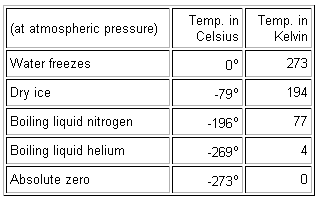 Laser trapping and cooling does just that. Photons, the quanta of light, carry momentum. When an atom absorbs a photon, the photon's momentum gives the atom a kick in the direction the photon was traveling. The atom can only absorb a photon if the photon's energy matches the energy difference between two of the atom's energy levels. Careful tuning of the laser frequency insures that only atoms moving toward the light can absorb photons and be slowed.
Laser trapping and cooling does just that. Photons, the quanta of light, carry momentum. When an atom absorbs a photon, the photon's momentum gives the atom a kick in the direction the photon was traveling. The atom can only absorb a photon if the photon's energy matches the energy difference between two of the atom's energy levels. Careful tuning of the laser frequency insures that only atoms moving toward the light can absorb photons and be slowed.
The crossed laser beams shown in the photo create a space picturesquely called "optical molasses." Atoms moving in this region, the bright area in the center of the picture, are trapped and cooled by absorption of photons from the crossed beams. With this technique, researchers have already reached temperatures lower than a millionth of a degree Kelvin. That's an average atomic speed on the order of centimeters per second.
Research
If an atom is moving towards or away from a laser beam, the atom sees a Doppler-shifted frequency. If the atom moves towards the beam, as shown in the drawing, the atom sees a slight increase in the laser frequency.
An atom can make a transition between two energy levels by absorbing or emitting a photon-a light quantum- provided the frequency f of the photon corresponds to the energy difference between two atomic levels. (The energy of the photon is directly proportional to the photon's frequency.) The drawing shows an atom with energies E1 and E2. Actually, each level has a small width in energy, so an atom can absorb energy over a small range of photon frequencies. The graph shows this range and displays the probability of photon absorption as a function of frequency for an atomic transition.
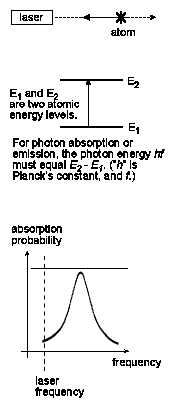 In laser cooling and trapping, the laser frequency is tuned below the center frequency of the center of this curve, as shown in the graph. If the atom moves towards the laser beam, the Doppler shift increases the light frequency in the atom's frame of reference. Thus the atom moving towards the beam has a higher probability of absorbing the photon and receiving a kick of momentum that slows the atom. However, if the atom is moving away from the beam, the Doppler shift reduces the light frequency and moves it further from the center frequency, thus further reducing the probability of photon absorption.
In laser cooling and trapping, the laser frequency is tuned below the center frequency of the center of this curve, as shown in the graph. If the atom moves towards the laser beam, the Doppler shift increases the light frequency in the atom's frame of reference. Thus the atom moving towards the beam has a higher probability of absorbing the photon and receiving a kick of momentum that slows the atom. However, if the atom is moving away from the beam, the Doppler shift reduces the light frequency and moves it further from the center frequency, thus further reducing the probability of photon absorption.
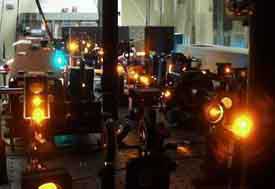
Laser Cooling and Trapping Laboratory at NIST (Gaithersburg, MD). Photo by Paul Lett.
Within about 10-8 seconds of absorbing a photon, the atom emits another photon and returns to its original state. The emission of this second photon gives the atom a kick in a random direction. The net effect of many such events is a slowing of the atom.
Atomic-Fountain Clock
The atom is a natural frequency standard. The arrangement of energy levels is characteristic of the atoms of a particular element, as is the frequency of the photon produced in a transition between two of these levels (see diagram below). A measurement of the photon frequency produces a standard of time based entirely on the properties of the atom.
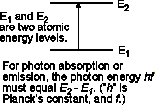 The atomic clock grew out of the radar technology of World War II. The first generation of these clocks irradiated a beam of hot atoms with microwaves at two points along the path of the beam. The longer the time between the application of the microwaves, the more accurate the clock.
The atomic clock grew out of the radar technology of World War II. The first generation of these clocks irradiated a beam of hot atoms with microwaves at two points along the path of the beam. The longer the time between the application of the microwaves, the more accurate the clock.
One MIT researcher predicted that an even better atomic clock could be made with ultracold atoms. Some forty years later, this prediction proved true.
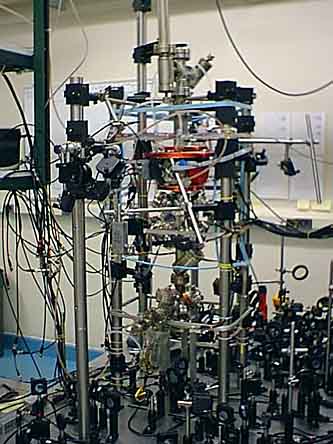
Juggling Laser-cooled atomic fountain (from laboratory of Kurt Gibble at Yale University): Clouds of laser-cooled Cesium atoms are tossed upwards in rapid succession in this atomic fountain. Because of the particular energy-dependence of the scattering, when tossed with the right time delay between tosses, the atoms pass right through one another. The juggling technique and the energy dependence of the scattering are important for future laser-cooled atomic clocks.
To build this kind of atomic clock, physicists, such as those at the National Institute of Standards and Technology (NIST), first make a cloud of ultracold atoms in an "optical molasses." A push from a laser beam underneath gives the cloud an initial upward velocity, and then all the lasers are turned off. Under the influence of gravity, the cloud rises and falls, like a ball tossed up in the air. This motion demonstrates that individual atoms move under the influence of gravity just like macroscopic objects, and in fact this experiment is called the "atomic fountain."
In the clock, microwaves irradiate the cloud as it rises and again as it falls, and the relatively long time of this motion increases the accuracy-the atomic fountain clock gains or loses only one second every 20 million years. Since one year contains about 3 x 107 seconds, that's an accuracy on the order of one part in l015.
Links
Physics 2000
National Institute of Standards and Technology (NIST)
Britannica
Scientific American
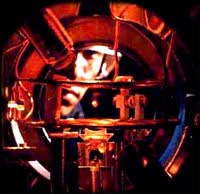
NIST physicist Kris Helmerson viewing a sample of magneto-optically trapped sodium atoms (small yellow dot in the center of the vacuum chamber) cooled to a temperature of less than 1 mK.














